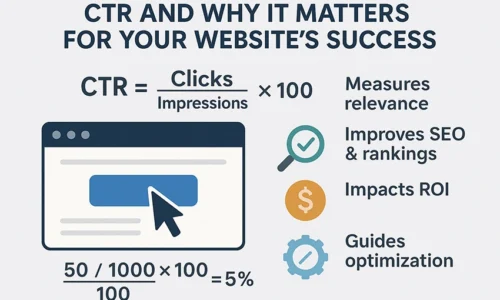
Every website owner dreams of higher conversions—turning casual visitors into paying customers. But achieving that requires more than just an attractive design and compelling content. Conversion rate optimization is a strategic process that enhances user experience, removes friction points, and persuades visitors to take desired actions.
Whether you run an e-commerce store, a service-based business, or a blog, CRO strategies can significantly impact your bottom line.
What Is Conversion Rate Optimization?
Conversion rate optimization improves a website or landing page to encourage visitors to take a specific action. This could mean purchasing a product, signing up for a newsletter, filling out a contact form, or downloading an eBook.
A website’s conversion rate is calculated as:
Conversion Rate (%) = (Conversions / Total Visitors) × 100
For example, if your website gets 1,000 visitors per month and 50 make a purchase, your conversion rate is 5%.
Why Is Conversion Rate Optimization Important?
Many businesses focus heavily on increasing website traffic, but those efforts go to waste if visitors don’t convert. CRO strategies help maximize the value of existing traffic, ensuring that more visitors become customers.
Optimizing conversions leads to higher revenue without the need to drive additional traffic. Instead of spending on ads, you can better use the visitors you attract. Additionally, it improves user experience by making the website more intuitive and easier to navigate. A well-optimized website also lowers customer acquisition costs since you get more value from each visitor. Ultimately, businesses with strong CRO strategies outperform their competitors in revenue generation and customer retention.
Proven CRO Strategies to Increase Website Conversion
Now that we understand the importance of CRO, let’s examine effective strategies for increasing website conversion rates.
1. Optimize Website Speed and Performance
A slow website kills conversions. Studies show that if a page takes over three seconds to load, more than half of users will leave before interacting with it. Compressing images and videos, choosing a fast hosting provider, enabling browser caching, and minimizing HTTP requests are some ways to improve site speed. Using a Content Delivery Network can enhance performance, especially for global audiences.
2. Improve Your CTA
Your CTA should be clear, direct, and visually appealing. Action-oriented language like “Buy Now,” “Get Started,” or “Sign Up Free” creates urgency and encourages users to take the next step. The placement of CTAs is just as important as their wording. They should be positioned above the fold and repeated at key touch points throughout the page to guide visitors toward action.
3. Use High-Quality Visuals and Design
A well-designed website keeps visitors engaged. High-quality images and graphics make content more appealing, while a clean and modern layout improves readability. Mobile responsiveness is also crucial, as more than half of users browse on their smartphones. Consistency in fonts, colors, and branding fosters trust and recognition, making users more comfortable converting.
4. Simplify Forms and Checkout Process
A complicated checkout or sign-up process often leads to cart abandonment. Reducing the required fields, enabling auto-fill, and offering guest checkout options can significantly improve conversion rates. Security badges and trust signals should also be displayed to reassure users that their data is safe.
5. Build Trust with Social Proof
People are more likely to convert when they see positive experiences from others. Customer reviews, testimonials, and case studies help build credibility. Highlighting media mentions or awards also strengthens trust. Displaying social media follower counts or engagement levels reassures visitors that others have found value in your offerings.
6. Personalize User Experience
Personalization makes visitors feel valued and understood. This can be done by showing relevant product recommendations, tailoring content based on user behavior, or sending personalized follow-up emails. Location-based services and targeted promotions also improve engagement by making offers more relevant to users.
7. Conduct A/B Testing
A/B testing involves creating different webpage versions to determine which one performs better. Testing variations of headlines, CTAs, page layouts, and colors helps identify what resonates most with visitors. Continuous testing and optimization ensure that CRO efforts yield the best possible results.
8. Reduce Distractions and Improve Navigation
A cluttered website can be overwhelming and lead to high bounce rates. Simplifying navigation menus and reducing excessive pop-ups keeps visitors focused on conversion goals. The whitespace enhances readability and directs attention to key elements such as CTAs and product descriptions.
9. Leverage Retargeting Strategies
Many visitors leave without converting, but retargeting can bring them back. Facebook and Google Ads allow businesses to retarget past visitors by showing them relevant ads. Abandoned cart emails and time-sensitive discount offers can also nudge hesitant customers toward completing their purchase.
10. Analyze Data and Optimize Regularly
Tracking performance metrics is essential for refining CRO strategies. Google Analytics provides insights into user behavior, while heatmaps show where visitors click and scroll. Collecting customer feedback through surveys helps identify areas of improvement. Continuous analysis ensures that conversion rates keep improving over time.
Common CRO Mistakes to Avoid
Even with great CRO strategies, mistakes can hinder success. One common issue is neglecting mobile optimization. A non-responsive site leads to missed conversions since a significant portion of web traffic comes from mobile users. Overcomplicating the process is another mistake. If forms or checkout steps are too lengthy, visitors may abandon them before completion.
Using generic CTAs is also a pitfall. A phrase like “Click Here” lacks urgency and clarity, whereas “Get Your Free Trial Today” gives a compelling reason to act. Additionally, failing to track performance means businesses miss out on valuable insights that could improve conversions. Avoiding these mistakes ensures better results from your CRO efforts.
Conclusion
Optimizing your website for conversions isn’t just about making it look good—it’s about strategically guiding visitors toward action. Implementing the CRO strategies discussed can increase website conversion rates, boost revenue, and improve user experience.
Start by testing one or two strategies, measure the impact, and refine continuously. With the right approach, you can turn more visitors into loyal customers and maximize the value of your existing traffic.




